Download User Manual PS 430 [ASL]
Transcript
PS 6379 Mk2 SIX CHANNEL MASTER SPEAKER STATION USER MANUAL October 2013 This product is designed and manufactured by: ASL Intercom B.V. Zonnebaan 42, 3542 EG Utrecht The Netherlands Tel: +31 (0)30 2411901 Fax: +31 (0)30 2667373 Email: [email protected] Web: www.asl-inter.com CONTENT OF THIS USER MANUAL 1.0 2.0 3.0 4.0 5.0 6.0 7.0 8.0 10.0 11.0 12.0 SAFETY INSTRUCTIONS ..................................................................... 3 GENERAL DESCRIPTION ................................................................... 4 UNPACKING ......................................................................................... 5 WARRANTY ......................................................................................... 5 INSTALLATION .................................................................................... 5 MAINS POWER & SAFETY EARTH ..................................................... 5 FRONT PANEL CONTROLS & CONNECTOR ..................................... 6 REAR PANEL CONNECTORS & SWITCHES .................................... 11 IFB FUNCTION ................................................................................... 14 DIP SWITCHES .................................................................................. 14 TECHNICAL SPECIFICATIONS ......................................................... 15 PAGE 2 User Manual PS 6379 Mk2 / October 2013 © ASL Intercom BV 1.0 SAFETY INSTRUCTIONS Please always follow these instructions to help ensure against injury to yourself and/or damage to the system Read all safety and operating instructions before you operate the apparatus. Retain all safety and operating instructions for future reference. Heed all warnings on the apparatus and in the operating instructions. Follow all installation, operating and use instructions. Unplug the apparatus from the AC power outlet before cleaning. Use only a damp cloth for cleaning the exterior of the apparatus. Do not use accessories or attachments not recommended by the manufacturer, as they may cause hazards and void the warranty. Do not operate this apparatus in high humidity areas or expose it to water or moisture. Do not place the apparatus on an unstable cart, stand, tripod, bracket or table. The apparatus may fall, causing serious personal injury and damage to the apparatus. Do not block or cover any openings in the apparatus. These are provided for ventilation and protection from overheating. Never place the apparatus near any heat sources such as radiators, heat registers, stoves, or other apparatus (including amplifiers) that produce heat. Do not place the apparatus in an enclosure such as a cabinet without proper ventilation. If the apparatus is mounted in a 19” rack, make sure that sufficient space around the unit (sides, top, and bottom) is provided to ensure free circulation of air. Insert the mains plug properly. Do not defeat the safety purpose of the polarized or grounding-type plug. An American polarized AC line plug has two blades with one wider than the other. This plug will fit only one way into the power outlet. This is a safety feature. If you are unable to insert the plug fully into the outlet, try reversing the plug. If the plug still fails to fit, contact an electrician to replace the obsolete outlet. A grounding type plug has two blades and a third grounding prong. The wide blade or the third prong are provided for your safety. If the provided plug does not fit into your outlet, consult an electrician to replace the obsolete outlet. Route power supply cords so that they are not likely to be walked on or pinched by items placed upon or against them. Pay particular attention to cords at plugs, convenience receptacles, and the point where they exit from the apparatus. Do not overload wall outlets or extension cords, as this can result in a risk of fire or electrical shock. Unplug this apparatus during lightning storms or when unused for long periods of time. Never insert objects of any kind into the apparatus through openings, as the objects may touch Dangerous voltage points or short out parts. This could cause fire or electrical shock. Refer all servicing to qualified service personnel. Servicing is required when the apparatus has been damaged in any way, such as when the power-supply cord or plug is damaged, liquid has been spilled or objects have fallen into the apparatus, the apparatus has been exposed to rain or moisture, does not operate normally, or has been dropped. Operate the apparatus using only the type of power source indicated on the marking label. Unplug the apparatus’ power cord by gripping the power plug, not the cord. PAGE 3 User Manual PS 6379 Mk2 / October 2013 © ASL Intercom BV 2.0 GENERAL DESCRIPTION The PS 6379 Mk2 is a master loudspeaker station with 6 intercom channels and a built-in power supply, offering full duplex communication with analog remote stations. The unit incorporates a loudspeaker, a gooseneck microphone and an XLR-4 headset connector. As an option, an XLR-6 headset connector can be fitted for binaural (split ear) use of the headset. By setting internally mounted jumpers, each of the 6 channels can be assigned to either the left or the right headset can, or to both headset cans. If the gooseneck microphone is active the loudspeaker is automatically attenuated. The degree of attenuation can be adjusted by a trimmer at the front panel. If a headset is connected, both gooseneck microphone and speaker are switched off automatically. The loudspeaker can be switched on again by pushing the Speaker on/off button. The PS 6379 Mk2 has newly designed mic input circuits with a proprietary limiter allowing to speak close and/or loud into the headset or gooseneck microphone without giving rise to overload and distortion The unique CALL system provides both a flashing red LED and a very distinctive sound signal (buzzer). The volume of the buzzer can be adjusted by a trimmer on the front panel. Front Panel Features (for each channel): • a TALK button with built-in green LED, • a CALL button with built-in red LED, • a Channel Volume control with “channel on/off switch”, • buzzer and mic mute buttons • an AUX Volume control • NULL ADJUST trimmers • an LED to indicate overload • an LED to indicate a system link connection. If TALK or CALL buttons are not active, they are lit in a white color, allowing to easily find these buttons in a dark environment. The light intensity of this so-called “backlight” can be adjusted (see Master Section Features). IFB function: Two channels of the PS 6379 Mk2 can be programmed to be so-called IFB (‘Interrupt Foldback’) channels, used for one way communication from i.e. a director/producer to a “talent” (e.g. a reporter or show presenter) in a broadcast environment. (see section 10.0) The talent has a headphone or an earpiece, connected to an analog IFB receiver or standard analog beltpack. Front Panel Features (Master Section): • a CALL TO TALK button • a TALK TO ALL button • a STAGE ANNOUNCE button • a SPEAKER ON/OFF button • a PGM (Program) Volume knob • a MASTER VOLUME knob • an “OWN VOICE” control knob • an ALL MICS MUTE button • an ALL BUZZERS MUTE button • trimmers for buzzer volume, loudspeaker attenuation, IFB Dim factor and backlight intensity • LEDs to indicate System Overload, DC power and Mains power. Rear Panel Features: • Intercom Line and System Link connectors for each channel • Connectors for Stage Announce audio output and Stage Announce relay • three electronically balanced auxiliary (AUX) audio inputs with ground lifts • AUX routing switches for each channel • an electronically balanced PGM input with ground lift switch • switches for putting channel E and F into IFB mode • a connector for an external loudspeaker • Mains and DC inlet connectors Power Supply: The built-in 105 watt (3.5 A) switch mode power supply is protected against a too high temperature and can easily drive up t 30 Pro Series beltpacks or 15 Pro Series 2-ch speaker stations, or a combination of both. The current on each channel is limited to 1.3 A, allowing to connect 10 Pro Series beltpacks or 5 Pro Series 2-ch speaker stations to a channel, or a combination of both. In case AC mains is not available, the unit may be powered by an external DC power source (24 – 30V) which can provide 105 watts. PAGE 4 User Manual PS 6379 Mk2 / October 2013 © ASL Intercom BV 3.0 UNPACKING The shipping carton contains the PS 6379 Mk2, a power cable, 2 fuses and a 19” rack mounting kit. After unpacking the unit please inspect for any physical damage to the unit and retain shipping carton and relevant packing materials for use should the unit need returning. 4.0 If any damage has occurred, please notify your dealer so that a written claim can be initiated. Please also refer to the warranty section of this user manual. WARRANTY This unit is warranted by ASL Intercom to the original end-user purchaser against defects in workmanship and materials in it’s manufacture for a period of 12 months from date of shipment to the end-user. Faults arising from misuse, unauthorized modifications or accidents are not covered by this warranty. 5.0 If the unit is faulty, it should be sent in its original packing to the supplier or local ASL dealer, with shipping prepaid. A note must be included stating the faults found and a copy of the original suppliers invoice. INSTALLATION Adequate ventilation must be provided by allowing sufficient space around the sides and rear of the unit to ensure free circulation of air. Forced cooling is not required. The power supply is mounted on the bottom of the unit. After a period of time the unit will feel hot to the touch at the top and the bottom; this is normal and should be no cause for alarm. To connect the PS 6379 Mk2 to the user stations, use professional flexible microphone cable with 2 wires and 1 shield only. 6.0 Connect these cables to the INTERCOM OUT connectors on the rear panel. The PS 6379 Mk2 is fully protected against wiring mistakes (e.g. reverse power) or short circuit in the interconnect cables. Included in the shipping carton is a kit for mounting the unit in a 19" rack, taking 2U of rack-space. MAINS POWER & SAFETY EARTH WARNING: This appliance must be earthed ! Connecting to mains power : The PS 6379 Mk2 may be connected to a mains power outlet which provides 100 – 240 V AC, 50-60 Hz, 200 watts. The outlet should have a clean earth. Avoid using mains power outlets which also power dimmer controlled lighting equipment. The wires in the mains lead are color coded: green/yellow: Earth / safety ground blue: Neutral brown: Live In case the wires in the mains lead do not correspond with the colored markings identifying the terminals in your mains plug, proceed as follows: • The wire which is colored green/yellow must be connected to the terminal in the plug which is marked with the letter “E”, or by the ground symbol, or is colored green. • The wire which is colored blue must be connected to the terminal which is marked with the letter “N” or colored black. • The wire which is colored brown must be connected to the terminal which is marked with the letter “L” or colored red. Safety Earth : For personal safety and proper operation of the PS 6379 Mk2 and connected stations the green/yellow wire of the mains lead must always be connected to the electrical installation safety earth or ground. This wire is in the PS 6379 Mk2 connected to all exposed metal surfaces. Any rack framework into which this unit might be mounted is assumed to be connected to the same grounding circuit. Switching On : To limit the inrush current after the PS 6379 Mk2 has been switched on, 30 V DC line power is provided to the intercom channels, one after the other. If a channel is found to have too many stations being connected or in case of short circuit, a circuit breaker immediately shuts off that channel from 30V DC line power. 7.0 If the total amount of to the PS 6379 Mk2 connected user stations is found to exceed the allowed maximum (see section 2.0), a “master circuit breaker” shuts off the line power to all channels. FRONT PANEL CONTROLS & CONNECTOR 1 TALK buttons Pushing these buttons allow talking to each channel separately or to some or all channels simultaneously. If a TALK button is switched on, its large green LED is lit. By pushing and holding the TALK button of a socalled IFB channel (see section 10.0), the TALK buttons of the intercom channels switch automatically off. To talk to an IFB channel and additionally to a intercom channel, one has to also push and hold the TALK button of that intercom channel. To achieve that one can talk to an IFB channel and to all intercom channels of which the TALK buttons are enabled (the corresponding Talk LEDs are lit), the position of a certain DIP switch has to be changed. See section 11.0, DIP switch A. Momentary switching: If a TALK button is pushed and held, the microphone signal is sent to the referring intercom channel until the button is released. Latched switching: If a TALK button is pushed shortly, it is electronically latched and the microphone signal is sent to the referring intercom channel. If pushed again, the TALK button switches off. For each channel the latch function can be disabled by changing the position of certain DIP switches (see section 11.0, DIP switch group E). The TALK button is then “momentary only”. 2 CALL button To activate the call system, for each channel separately. By a momentary push a visual CALL signal is sent to all stations connected to the referring intercom channel and the call LEDs start flashing. By holding the CALL buttons for 2 seconds the buzzers are activated, provided there is no buzzer mute status on that channel. After the CALL button is released the LEDs continue to flash for a further 2 seconds. The CALL function of a channel in IFB mode is automatically disabled. 3 NULL ADJUST trimmers With these trimmers (one set for each channel) one may minimize the speaker feeding back into the gooseneck microphone (unit feedback) and for minimizing the headset mic feeding back into the headset can(s); the LOW trimmer is for all frequencies, the HIGH trimmer solely for the high frequencies. PAGE 6 User Manual PS 6379 Mk2 / October 2013 © ASL Intercom BV Null Adjustment procedure, for each channel separately: • turn the ‘Own Voice” (side tone) control knob to minimum • set Null Adjust trimmers in start position: fully clockwise. • switch off the microphones of all connected (speaker-) stations • make sure that there is no automatic speaker attenuation (turn trimmer #21 fully clockwise) • push the TALK button of the channel to be null adjusted • slowly turn up the listen volume of the PS 6379 Mk2 (channel + master volume) • speak into the gooseneck microphone • adjust the speaker listen level to a minimum by turning the null adjust trimmers counterclockwise (first the LOW trimmer and then the HIGH trimmer; repeat this a few times) • Connect a headset (the loudspeaker and gooseneck mic are now automatically disabled) and speak into the headset microphone. Check whether the level of your voice in the headset can(s) is sufficient. If not, push this level up by turning the OWN VOICE knob ( #4) clockwise. The operating area of the Null Adjust trimmers is between fully clock-wise and minimum level. Should the number of user stations on a channel and/or the length of the party line cable change, the null for that channel has to be adjusted again. 4. OWN VOICE control knob With this knob one adjusts the extent to which the headset mic signal is heard in your headset cans. 5 CHANNEL VOLUME knob To adjust the listen level of the corresponding channel. Turning a knob fully counter-clockwise switches that channel off (the channel is disabled, see also #6). For as long as the TALK button of an IFB channel is kept pushed, the Listen function of the intercom channels is automatically disabled. To achieve that these Listen functions are not disabled if an IFB TALK button is pushed, the position of a certain DIP switch has to be changed. See section 11.0, DIP switch B 6 CHANNEL ON LED indicator This green LED is lit when the corresponding channel is switched on. In case the channel is switched off by the CHANNEL VOLUME knob (#5), its TALK, CALL and LISTEN controls are disabled. (Line power to the channel remains). 7 MIC MUTE button By pushing this button the TALK button of the corresponding PS 6379 Mk2 channel is disabled, by which also the TALK buttons on remote stations are disabled (the ones of the remote station channels which are connected to the corresponding PS 6379 Mk2 channel). A disabled TALK button can be enabled again by pushing it. The MIC MUTE button of a channel in IFB mode is automatically disabled 8 BUZZER MUTE button By pushing this button the buzzers of all stations connected to the corresponding (party line) channel can be remotely muted. After being pushed the Buzzer Mute button is lit. The buzzers remain being muted until the BUZZER MUTE button is switched off again (the Buzzer Mute status is abolished). The BUZZER MUTE button of a channel in IFB mode is automatically disabled. PAGE 7 User Manual PS 6379 Mk2 / October 2013 © ASL Intercom BV 9 AUX Volume knob By turning this knob one adjusts the level of the auxiliary signal as sent to the corresponding channel. The AUX signal may originate from either AUX input 1, AUX input 2 or AUX input 3 (see AUX inputs #34 and AUX select switches #35) 10 SYSTEM LINK LED This yellow LED illuminates if a channel of another ASL Intercom System has been connected to the PS 6379 Mk2 through the “System Link” connector (#33) of the corresponding channel. The “other system” channel is now the MASTER channel and the ‘linked’ PS 6379 Mk2 channel the SLAVE channel (The line impedance is now provided by the MASTER channel and the line impedance of the SLAVE channel is switched off). One can talk, listen and call to and from all user stations which are connected to the MASTER channel and to the SLAVE channel. A Mic Mute signal sent from the MASTER channel to the SLAVE channel is also received by the user stations on that channel. But a Mic Mute signal sent from the PS 6379 Mk2 is only received by the user stations on its own channels (it does not mute the microphones of the user stations on the MASTER channel) A Buzzer Mute signal on the MASTER channel is received by the user stations on that channel and by the user stations on the SLAVE channel. A SLAVE channel is not able to generate a Buzzer Mute signal (the Buzzer Mute button of the SLAVE channel is disabled). 11 ON/OVERLOAD LED This LED is lit green when 30 V DC line power is supplied to the corresponding channel. The LED is lit red when too many user stations have been connected to the corresponding channel or if there is a short circuit on that channel. A circuit breaker immediately disconnects the line power from that channel and resets (restores line power) automatically within 2 seconds after the cause of the overload has been removed. 12 IFB MODE LED indicator (for channels E and F only) This yellow LED is lit if the channel is put into IFB mode, see section 10.0 13 TALK TO ALL button By pushing and holding this (momentary only) button one may talk to all intercom channels simultaneously. The green LEDs in the TALK buttons of all channels light up, except for the LEDs in the TALK buttons of the channels in IFB Mode. To also include the TALK buttons of the channels in IFB Mode, the position of certain DIP switches have to be changed (see section 11.0, DIP switch C). 14 CALL TO TALK button By shortly pushing this (momentary only) button a visual Call signal is simultaneously sent to all channels of which the TALK buttons are switched on. All corresponding Call LEDs of the PS 6379 Mk2 (except the ones of the channels in IFB Mode) and of all connected stations start flashing. When holding the CALL TO TALK button pushed for 2 seconds the buzzer is activated, should no buzzer mute be activated for that channel. After the CALL TO TALK button is released the LEDs continue to flash for a further 2 seconds. PAGE 8 User Manual PS 6379 Mk2 / October 2013 © ASL Intercom BV 15 MASTER VOLUME knob By turning this knob one adjusts the volume of the sum of all intercom signals as heard in the loudspeaker and/or headset. This knob may also adjust the master volume control for both the intercom and the PGM (Program Audio) signals, depending on the position of jumpers #44. 16 PGM VOLUME By turning this knob one adjusts the listen volume of the PGM input. The signal of the PGM input can only be heard on the speaker and/or headset of the PS 6379 Mk2 and does not appear on the intercom lines. If a TALK button is pushed and the speaker is On, the speaker is automatically attenuated. This diminishes the effect that the PGM signal goes from the speaker into the microphone). The position of jumpers #44 determine whether the program audio listen level is also controlled by the Master Volume knob (#15). 17 STAGE ANNOUNCE button By pushing this button the microphone signal is directly routed to the line level output at the rear panel. The microphone signal (the ‘Announce’) is not sent to the intercom channels. Whilst the Stage Announce button is kept pushed, the channel TALK buttons are disabled (the built-in LEDs extinguish if they were lit before) and the speaker is automatically switched off. To achieve that the speaker is not automatically being switched off, the position of a certain DIP switch has to be changed. See section 11.0 DIP switch D). 18 SPEAKER ON/OFF button With this button the loudspeaker can be switched on or off. The LED in the button is lit when the speaker is switched on. As soon as a headset is plugged in, the speaker is automatically disabled (if it was enabled before). By pushing the speaker on/off button, the speaker is enabled again and the audio can be heard over both the speaker and the headset. When unplugging the headset, the speaker setting (on or off) is as before the headset was plugged in. 19 ALL MICS MUTE button By pushing this button the TALK buttons of the PS 6379 MK2 and the TALK buttons of the connected remote stations are disabled (if they were previously enabled). After the ALL MICS MUTE button is being pushed, it is lit for a few seconds. Also all channel MIC MUTE buttons (#7) are lit for a few seconds. Disabled TALK buttons (on the PS 6379 MK2 or on a connected remote intercom station) can be enabled again by pushing them. 20 ALL BUZZERS MUTE button By pushing this button the buzzers of the connected stations and of the PS 6379 Mk2 can be muted. After being pushed, all channel Buzzer Mute buttons (#8) are lit. The buzzers remain being muted until the ALL BUZZER MUTE button is switched off again (the buzzer mute status is abolished). The channel Buzzer Mute buttons return to their previous status (the ones which were lit before the ALL BUZZER MUTE button was pushed remain being lit) PAGE 9 User Manual PS 6379 Mk2 / October 2013 © ASL Intercom BV 21 SPEAKER ATTENUATOR trimmer To adjust the extent to which the loudspeaker is automatically dimmed when the gooseneck microphone is switched on. It prevents unit feedback if Null Adjust is not sufficient. It also minimizes system feedback or a 'hollow' sound when the gooseneck microphones of other speaker stations (on one or several of the connected party lines) are switched on as well. Adjustment procedure : • make sure that there is no headset connected • switch off all TALK buttons of the PS 6379 Mk2. • feed an audio signal to an intercom channel (see #9 and #34) • turn up the listen volume of the PS 6379 Mk2 (selected channel and master volume) • activate the gooseneck microphone (push the TALK button of the selected channel) • adjust the desired degree of speaker attenuation (turning the trimmer counterclockwise increases the attenuation) 22 BUZZER VOLUME trimmer To adjust the volume of the internal buzzer. 23 IFB DIM FACTOR trimmers By turning these trimmers, the IFB DIM factor for channel E and channel F can be set, should these channels being put into IFB Mode (see switches #36). The IFB Dim Factor is the extent to which the AUX signal is dimmed (0% to 100%) when pushing the TALK button of a channel which is put into IFB mode. If the knob is fully clockwise, the DIM factor is at its maximum (100% dimming) 24 BACKLIGHT trimmer If TALK or CALL push buttons are not active, they are lit white allowing to easily find these buttons in a dark environment. By turning this trimmer the light intensity can be adjusted. 25 Master OVERLOAD LED indicator As soon as more than the allowed maximum allowed user stations are connected to the PS 6379 Mk2 (the current from the built-in PSU is in danger to exceed 5A) the red Overload LED is lit and a circuit breaker disconnects the line power from all channels. The circuit-breaker resets (restores line power) automatically 3 seconds after the cause of the overload has been removed. The LED also lights up red - for a few seconds - every time mains power is switched on. 26 MAINS LED indicator If mains power is switched on (see #31 ‘Mains Power On/Off switch’) this green LED is lit. 27 DC power LED indicator If the DC input on the rear panel (see #41) receives DC power (24 – 30V / 5A) this yellow LED is lit. 28 HEADSET connector To this XLR-4 connector of a headset can be connected. The headset must have a can impedance of minimum 200 ohms. If the headset has two cans in parallel, each can must have an impedance of minimum 400 ohms. The headset microphone may be of the dynamic or electret type. .A limiter prevents the mic preamp from clipping when speaking close or loud into the headset microphone.The gain for the headset mic can be adjusted by trimmer #45. PAGE 10 User Manual PS 6379 Mk2 / October 2013 © ASL Intercom BV Headset connector pin assignments : Pin 1. Shield mic. (GND) Pin 2. mic. + Pin 3. phones + Pin 4. phones When a headset is connected, speaker and gooseneck microphone are disabled automatically. The speaker can be enabled again by pushing the SPEAKER on/off button (#18). The PS 6379 Mk2 can optionally be equipped with an XLR-6 headset connector for binaural use of the headset. Internal jumpers determine - for each channel separately - the routing of the audio to the headset cans: either to the left can, or to the right can or to both cans. (See #43 ‘Binaural Jumper Settings’). 8.0 29 GOOSENECK microphone This is an electret noise cancelling microphone. A limiter prevents the mic pre-amp from clipping when speaking close and/or loud into the microphone. The microphone is automatically disabled when a headset is connected to the PS 6379 Mk2. The mic gain can be adjusted by trimmer #46 30 LOUDSPEAKER A high quality 16 Ω loudspeaker. The speaker is automatically disabled if a headset is connected. It can be switched on again by pushing the SPEAKER On/Off button( #18). 31 POWER ON/OFF push button To switch the internal power supply On or Off. REAR PANEL CONNECTORS & SWITCHES 32 INTERCOM OUT connectors (one per channel) These male XLR-3 connectors are for connecting the intercom party lines to which remote stations can be connected, via standard microphone cable. Pin assignment: Pin 1: 0V / ground Pin 2: +30 V power wire Pin 3: Audio wire SYSTEM LINK connectors (one per channel) These female XLR-3 connectors are inputs for the intercom cables of another ASL party line Intercom system which has its own power supply. For more information, see #10 34 AUX INPUT connectors + ground lift switches These three XLR-3 female connectors are inputs for auxiliary (AUX) audio signals. The inputs are electronically balanced and accept line level audio signals. For routing these AUX signals to the intercom channels, see #35. Pin assignment of all AUX input connectors: Pin1. 0V / ground Pin 2. Signal + Pin 3. Signal - 33 35 AUX SELECT switch (one per channel) A 3-position switch to route either AUX 1 or AUX 2 or AUX 3 to the corresponding channel PAGE 11 User Manual PS 6379 Mk2 / October 2013 © ASL Intercom BV 36 IFB mode switches E and F To put channel E and/or F into IFB mode 37 PGM INPUT connector + ground lift This XLR-3 female connector is an electronically balanced input for line level audio signals. The input is for receiving a program (PGM) audio signal, which is routed to the loudspeaker and the headset connector only. The PGM volume can be adjusted by knob #16. 38 STAGE ANNOUNCE OUT connector This XLR-3 male connector is electronically balanced output for the pre-amplified microphone signal at line level when the STAGE ANNOUNCE button is pushed. 40 EXT. SPEAKER connector To this 6.3 mm jack connector an external speaker can be connected. When an external speaker is connected, the internal speaker switches off and the audio is sent to the external speaker. 41 DC Power Input connectors These two connectors allow external DC power (24 – 30V / 5 A) to be the back-up power supply or to be the main power supply should AC mains not be available. 42 Mains Power Inlet Mains inlet (100 –240 V AC, 50/60 Hz, 200 watt) and fuse holder ( Fuse: 4 Amp slow blow) 39 STAGE ANNOUNCE RELAY This Phoenix type connector gives access to a normally open contact, which is closed when the Stage Announce button is pushed. 9.0 INTERNAL CONTROLS PAGE 12 User Manual PS 6379 Mk2 / October 2013 © ASL Intercom BV 43 Binaural Jumper Settings The PS 6379 Mk2 can optionally be equipped with an XLR-5 headset connector for binaural use. In that case the position of jumpers determine - for each channel separately - the routing of the audio to the headset cans: either to the left can, or to the right can, or to both cans or not to any can. 44 PGM ROUTING jumpers With these three jumpers one determines whether the PGM (program audio) listen level is also controlled by the Master Volume knob (see #6) and – in case of binaural use of the PS 6379 Mk2 – the routing of the PGM signal to the headset cans. 45 HEADSET MIC GAIN trimmer With this trimmer the gain of the headset microphone can be adjusted (factory set for a dynamic headset microphone). 46 GOOSENECK MIC GAIN trimmer With this controls the gain of the gooseneck microphone can be adjusted (factory set for the electret gooseneck microphone). PAGE 13 User Manual PS 6379 / May 2011 © ASL Intercom BV 10.0 IFB FUNCTION With the IFB Mode switches #36 on the rear panel, channel E respectively channel F can be put into IFB Mode, which is indicated on the front panel by lit IFB Mode LED indicators. The channel is now a so-called IFB channel, used for one way communication from i.e. a director/producer to a talent in a broadcast environment: If the director pushes the TALK button of an IFB channel, the talent hears the producer but may also listen to an auxiliary signal. The talent has a headphone or an earpiece, connected to a PS-10 analog IFB receiver (1 channel / listen only) or a standard 1-channel ASL analog beltpack. IFB channel Properties: • The TALK button of an IFB channel is momentary only and must be kept pushed while talking. • Whilst the TALK button of an IFB channel is kept pushed the level of the AUX signal to that channel is dimmed automatically. This is the so-called IFB Dim Factor which can be adjusted (0% to 100%) by turning knobs #23 for each IFB channel separately . • For as long as the TALK button of an IFB channel is kept pushed, the TALK buttons of the intercom channels are switched off automatically. To achieve that one can talk to an IFB channel and to all intercom channels of which the TALK buttons are enabled (the corresponding Talk LEDs were lit), the position of a certain DIP switch has to be changed. See section 11.0, DIP switch A • • • For as long as the TALK button of an IFB channel is kept pushed, the Listen functions of the intercom channels are disabled automatically (one does not hear the communication on the intercom channels). To achieve that these Listen functions are not disabled if an IFB TALK button is pushed, the position of a certain DIP switch has to be changed. See section 11.0, DIP switch B The CALL function of an IFB channel is automatically disabled (one can’t send a Call signal from and does not receive a CALL signal on such a channel) Both the Mic Mute button (#7) and the Buzzer Mute button (#8) of an IFB channel are automatically disabled. Pushing the ALL MIC MUTE button or the ALL BUZZER MUTE button has no effect on a channel which is in IFB mode. WARNING: A channel from another intercom system should via its system link connector not be linked to a channel which is in IFB mode. 11.0 DIP SWITCHES Inside the PS 6379 Mk2 the following DIP switches are to be found: PAGE 14 User Manual PS 6379 Mk2 / October 2013 © ASL Intercom BV DIP switch A IFB and TALK If this DIP switch is in ‘OFF’ position (= factory setting) and the Talk button of an IFB channel is pushed and held, the microphone signal is not sent to the intercom channels. In the ‘ON’ position and the TALK button of an IFB channel is pushed and held, the microphone signal is also sent to all intercom channels of which the Talk LED is lit. DIP switch B IFB and LISTEN If this DIP switch is in ‘OFF’ position (= factory setting) and the Talk button of an IFB channel is pushed and held, the Listen function of the intercom channels is disabled. In the ‘ON’ position and the TALK button of an IFB channel is pushed and held, the Listen function is not automatically disabled. DIP switch C IFB and TALK TO ALL If this DIP switch is in ‘OFF’ position (= factory setting) and the TALK TO ALL button is pushed and held, the microphone signal is only be routed to the intercom channels. In the ‘ON’ position and the TALK TO ALL button is pushed and held the microphone signal is also be routed to the channels which are in IFB mode. DIP switch D STAGE ANNOUNCE and SPEAKER ON/OFF If this DIP switch is in ‘OFF’ position (= factory setting) the speaker of the PS 6379 Mk2 is automatically switched off for as long the STAGE ANNOUNCE button is being pushed. In the ‘ON’ position, the speaker is not switched off for as long as the STAGE ANNOUNCE button is being pushed. DIP switches E TALK MOMENTARY ONLY (per channel) If a DIP switch in this block is in the ‘OFF’ position (= factory setting) the TALK button of the corresponding channel is latching or momentary. In the ‘ON’ position the TALK button of the corresponding channel is ‘momentary only’ (the latch function is disabled). Please not that the TALK button of an IFB channel is a momentary only anyway. 12.0 TECHNICAL SPECIFICATIONS Intercom System dynamic range: 80 dB frequency response : 200 Hz – 15 kHz (-3 dB) call send signal: +2.8 mA call signal threshold (receive): +2.4 V DC operating voltage: 24 - 30 V DC power interrupt time (mic mute): 0.1 sec line Impedance: 390 Ω (1kHz), 2.2 kΩ (DC) audio level: nom. -18 dBu, max. 0 dBu Headphones Driver Amps max. output level: monaural: 16 Vrms @ 200 Ω binaural: 2x 10.3 Vrms @ 400 Ω max. output power: monaural: 1.3 Wrms @ 200 Ω binaural: 2x 0.27 Wrms @ 400 Ω Switch Mode Power Supply module mains voltage : 100 – 240 V AC, 50/60 Hz output voltage: +30 V DC (+/- 5%) max. output power: 105 watts circuit breaker delay time: 0.2 sec. automatic reset time: 1.8 sec. Program & AUX Inputs input impedance: 2.4 kΩ nominal input level: 0 dBu max. input level: +21 dBu Microphone Pre-amps gain: 40 - 60 dB (adjustable internally) presence filter: +6 dB at 5 kHz power to electret mic: +9 V DC limiter range (both mics): 30 dB Null Adjust Rejection: 0 - 30dB adjustable Stage Announce Output output impedance: 50 Ω (balanced) nominal Output Level: 0 dBu max. Output Level: +21 dBu Dimensions & Weight width: 420 mm / height: 88 mm depth: 220 mm / weight: 4800 gram Speaker Driver Amp max. output power: 1.7 Wrms @ 16 Ω DC input: Supply Voltage: 24 – 30 V DC Buzzer Max. SPL: 90 dBA @ 0.1 m 0 dBu is defined as 775 mV into open circuit. PAGE 15 User Manual PS 6379 / May 2011 © ASL Intercom BV
















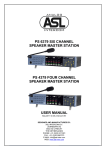
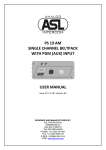
![User Manual PS 150 [ASL]](http://vs1.manualzilla.com/store/data/005768686_1-8816d5b7fb10913376d12c46f49c4ab8-150x150.png)
![User Manual PS 260 [ASL]](http://vs1.manualzilla.com/store/data/005812810_1-b4fa2f2c5a395900ef391b5dff7111b5-150x150.png)


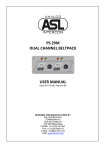


![User Manual BS 15 [ASL]](http://vs1.manualzilla.com/store/data/005675346_1-422b291500c6ff99ebe2f8b515793259-150x150.png)
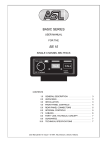

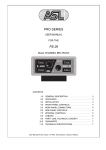
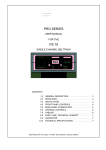

![User Manual PS 260 [ASL]](http://vs1.manualzilla.com/store/data/006916739_1-983cb380987130e2fe2cf762515f3398-150x150.png)
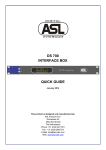

![User Manual PS 260 [ASL]](http://vs1.manualzilla.com/store/data/005887031_1-132c7eb8ac96774a27528798f7f3ad09-150x150.png)
![User Manual PS 260 [ASL]](http://vs1.manualzilla.com/store/data/005875222_1-79f7ffd37f8e6cc3732f57605cc0b82b-150x150.png)
